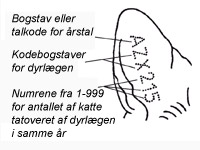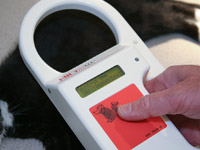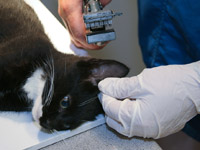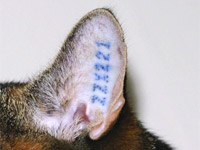Registration
Ear tattoo or microchip – Which should I choose?
In Denmark, ear tattooing is still the traditional way to mark cats, and previously also dogs, but these are only micro chipped now. Tagging with a microchip under the skin on the neck is by far the best and statutory form of identification if you want to take your cat abroad. A chip can be practical if you have a chip-controlled cat flap that prevents strange cats from entering. However, ear tattoos have the benefit of instantly showing whether, for example an injured cat has an owner, whereas a chipped cat’s identity can only be revealed using a scanner. Nevertheless, a chip always works, whereas an ear tattoo may disappear over time, either because the code numbers will have blended together, disappeared or been damaged through injury.
When should it be done?
 You can microchip a kitten from the day it is born. The chip number contains 15 digits, the first three refer to a country code (Denmark), the next three digits are from the chip manufacturer, and the remaining digits represent a unique number, which ensures that no two animals ever have the same number, and that the owner can always be traced. If you prefer to have the cat tattooed, you must wait until the kitten is 14-16 weeks when the ears are big enough. An ear tattoo measures almost the entire length of the ear with six digits; most often three letters, one for the year and two for the vet and thereafter three digits for the number of cats tattooed by the vet in the same year. The chip does not reveal the identity of the vet who has placed the chip, as the ear tattoo does. However, unlike the ear tattoo, the chip does have a country code.
You can microchip a kitten from the day it is born. The chip number contains 15 digits, the first three refer to a country code (Denmark), the next three digits are from the chip manufacturer, and the remaining digits represent a unique number, which ensures that no two animals ever have the same number, and that the owner can always be traced. If you prefer to have the cat tattooed, you must wait until the kitten is 14-16 weeks when the ears are big enough. An ear tattoo measures almost the entire length of the ear with six digits; most often three letters, one for the year and two for the vet and thereafter three digits for the number of cats tattooed by the vet in the same year. The chip does not reveal the identity of the vet who has placed the chip, as the ear tattoo does. However, unlike the ear tattoo, the chip does have a country code.
How chipping is done

Chipping is done by injecting an ISO-approved microchip under the skin to the left-hand side of the neck. The cat does not need sedation, the injection of the chip is just like any normal injection. It only takes a couple of seconds and does not hurt. The chip remains in the place it was inserted. If the chip moves, which is very rare, it can be due to a production fault in the chip. But it does not travel round the body. It is not dangerous. It will not hurt or hinder the animal’s movements. Chipping is always done on the left-hand side of the neck on cats, dogs, horses and other animals chipped in Europe, so that everyone knows where to look with the scanner.
How ear tattoos are done
 Cats must be sedated before having an ear tattoo, to avoid feeling pain. It can sometimes be done at the same time as the kitten’s second set of vaccinations, when it is 14 weeks old, or at the same time as sedation for neutering. If you have an older cat that is not tattooed, but needs to be sedated for whatever reason during a visit to the vet, then this would also be a good time to have it done.
Cats must be sedated before having an ear tattoo, to avoid feeling pain. It can sometimes be done at the same time as the kitten’s second set of vaccinations, when it is 14 weeks old, or at the same time as sedation for neutering. If you have an older cat that is not tattooed, but needs to be sedated for whatever reason during a visit to the vet, then this would also be a good time to have it done.

Once the cat is sedated, it sleeps soundly and does not feel a thing, even though its eyes remain open. Cats usually have their eyes open under sedation, and the vet will put some cream on them to avoid them drying out. It may sometimes be necessary to cut some of the hair from the ear. The ear is always cleaned first. The vet then takes his tattoo tongs, which puts holes in the cat's ears, squeezing around the ear while counting to 20. The tongs are turned and the other ear is tattooed so that the code is the other way round in this ear, to make it easier to read should the other ear become injured in the future. The tongs are removed and tattoo dyes are rubbed into the holes in the ears. The ears are dyes green or black, depending on the dye used by the vet. After a couple of weeks, the excess dye comes off and the number code remains.
When your cat has been ear tattooed or chipped
After the ear tattoo or chip, the vet fills out a form, which is sent to The Danish Cat Register. This ensures that the cat's and your details are registered in the national register and on this website. You will receive an email with instructions on how to log in to Min side with NemID in order to confirm ownership.
The Danish Cat register is constantly updating its database, so that by the time you receive the cat’s registration certificate, you can enter the site yourself to check if your cat is registered. If you have got a cat from another family, you can also check whether your new cat is registered. If you have any questions please contact The Danish Cat Register on +45 70 27 04 47 or send an e-mail to info@katteregister.dk to check that your cat’s data has been updated. You can at the same time also give your permission for this information to be available on the website, if you so wish.
On page Search, click on "Instructions" to see who can search the register and how to read ear tattoos.
Kommunesamarbejde
Kommer en kat væk hjemmefra, og er den mærket, er der større chance for at katten kan komme tilbage til sin ejer, når den bliver fundet af andre end ejeren selv.
Øretatoveringer kan aflæses direkte af alle, hvorimod katte der er mærket med en chip under huden, ikke umiddelbart er synligt mærkede - det kræver en speciel scanner af lokalisere og aflæse chippen.
Det Danske Katteregister har derfor tilbudt gratis chipscannere til alle landets kommuner, således katteejere kunne få vished for deres kæledyrs skæbne, hvis en bortløben kat, i en eller sammenhæng, bliver lokaliseret af kommunalt ansatte medarbejdere.
Følgende kommuner har taget i mod tilbuddet.